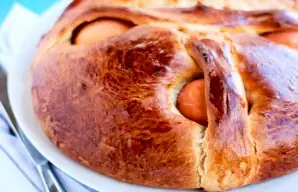Posted on Wednesday, May 13, 2020 in
Bread Recipes
Julie's Delicious Portuguese Corn Bread Recipe
Julie's delicious Portuguese corn bread (pão de milho), is her family favorite, please leave a comment below and tell me what you think.
| Preparation time | n/a |
| Cooking Time | 30 min |
| Ready In | 5 h 5 min |
| Level of Difficulty | Easy |
| Servings | 10 |
Ingredients
Yeast:1 tablespoon of active dry yeast1/4 cup of warm water (between 90 and 112 degrees Fahrenheit)1/2 Tablespoon of all-purpose flourDough:2 cups of finely ground corn flour3 to 3 and 1/4 cups of boiling water, divided1 tablespoon of salt2 cups of all purpose flour
Get Portuguese ingredients 
Preparation
Yeast:
- Dissolve the yeast in the warm water and set aside for 10 minutes.
- Mix in the 1/2 tablespoon of flour, cover and set aside for 1 hour.
Bread.
- Place the corn flour in a large bowl.
- Dissolve the salt in 2 1/2 cups of the boiling water.
- Add the salted water over the corn flour and, stirring quickly, mix them thoroughly, making sure all flour is moistened (it should look like lumpy mashed potatoes).
- Set aside until it is cool enough to handle, about 15 or 20 minutes.
- When the corn flour has cooled, gradually mix in the all-purpose flour, the yeast, and an additional 1/4 cup of the remaining water, which should be just warm at this point.
- Mix until the dough comes together.
- If the dough seems a little dry, mix in more of the remaining water to make the dough more pliable (use as little of the water as you can).
- Knead the dough in the bowl for about 10 minutes, until it feels sticky.
- Dust the dough with flour, cover it with a clean dishtowel and set it aside in a warm, draft-free spot to rise until double, about 2 1/2 hours.
- Preheat the oven to 260°C or 500°F.
- When the dough has doubled, do not punch down.
- Divide it into 2 pieces carefully, without deflating the dough.
- Swirl some water in another bowl, pour it out and sprinkle some flour in bowl to stick to the sides.
- Place one piece of the dough in the bowl and roll it around to shape it into a rough ball.
- Empty/invert the bowl over a round cake pan or metal pie plate and repeat with the other dough.
- Place the pans in the middle rack of the oven and bake for 30 minutes.
- The bottom should sound hollow when tapped and the outside of the loaf a golden brown color.
- Allow it to cool for 20 minutes before cutting.
Recipe & Photo Credit: Julie, facebook.com/JuliasCooking
Recommended Recipes
Incredibly Tasty Garlic and Cheese Bread Recipe
Incredibly tasty garlic and cheese bread recipe, a garlic butter mixture, is topped with Parmesan and Mozzarella Cheese to make it incredible.
| Level of Difficulty | Very Easy |
| Servings | 6 |
Delicious Portuguese Bolo Levedo Recipe
Tender, slightly sweet, and utterly delightful, these delicious Portuguese bolo levedo (Portuguese muffins) are perfect any way you slice it.
| Level of Difficulty | Easy |
| Servings | 10 |
Traditional Portuguese Easter Sweet Bread Recipe
This traditional Portuguese Easter sweet bread (folares de pascoa), is delicious and very popular during Easter.
| Level of Difficulty | Easy |
| Servings | 8 |
Comments



Linda
Is it regular white or yellow cornmeal as that is what is used to make cornbread and for coating fish. I have never seen corn flour in a grocery store.
3 Years ago, Friday, June 3, 2022

Marcia
Which corn flour?
The fine like the white flour
Or the thicker flour with the little grinds in it?
Thank you
4 Years ago, Thursday, February 3, 2022




